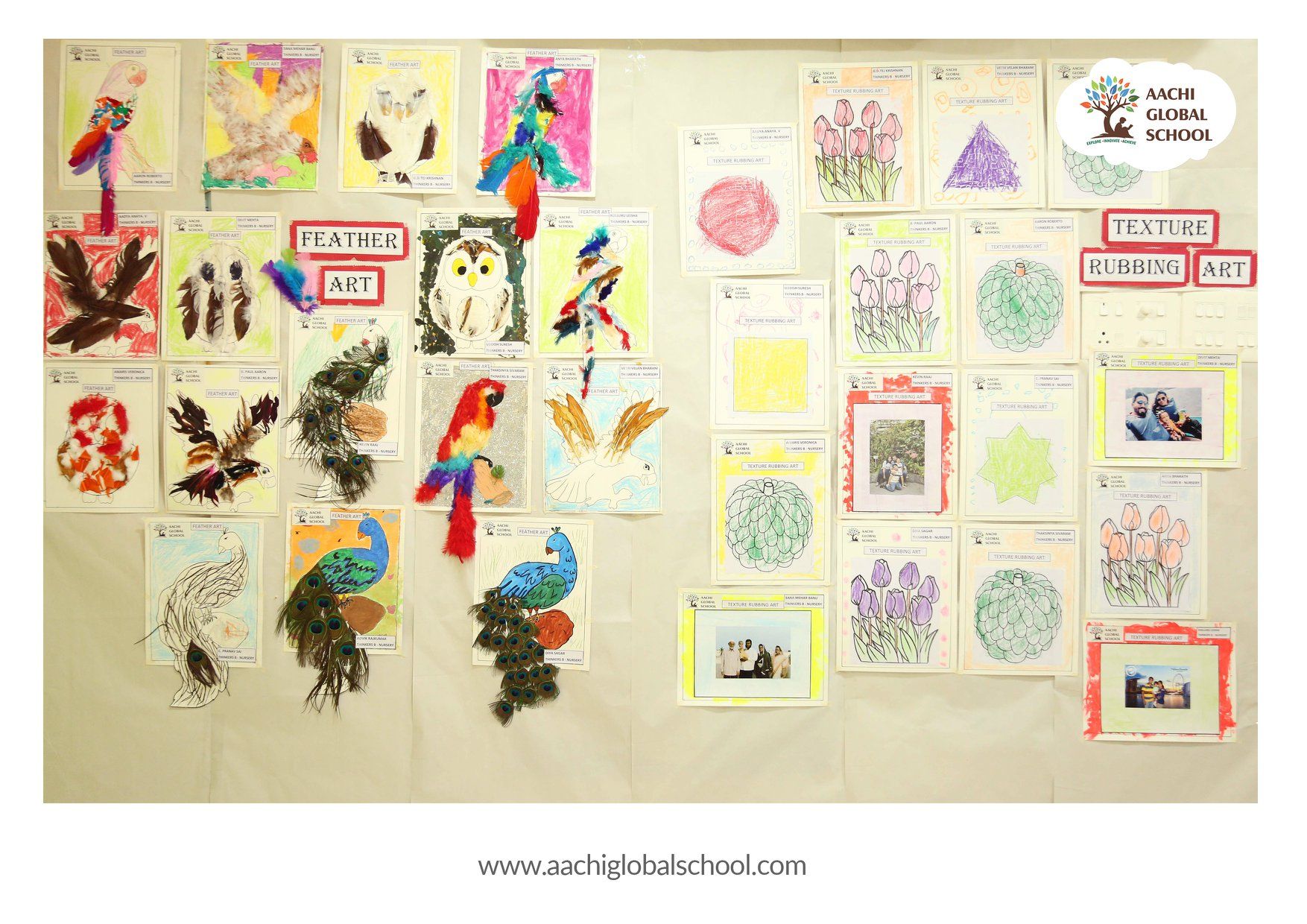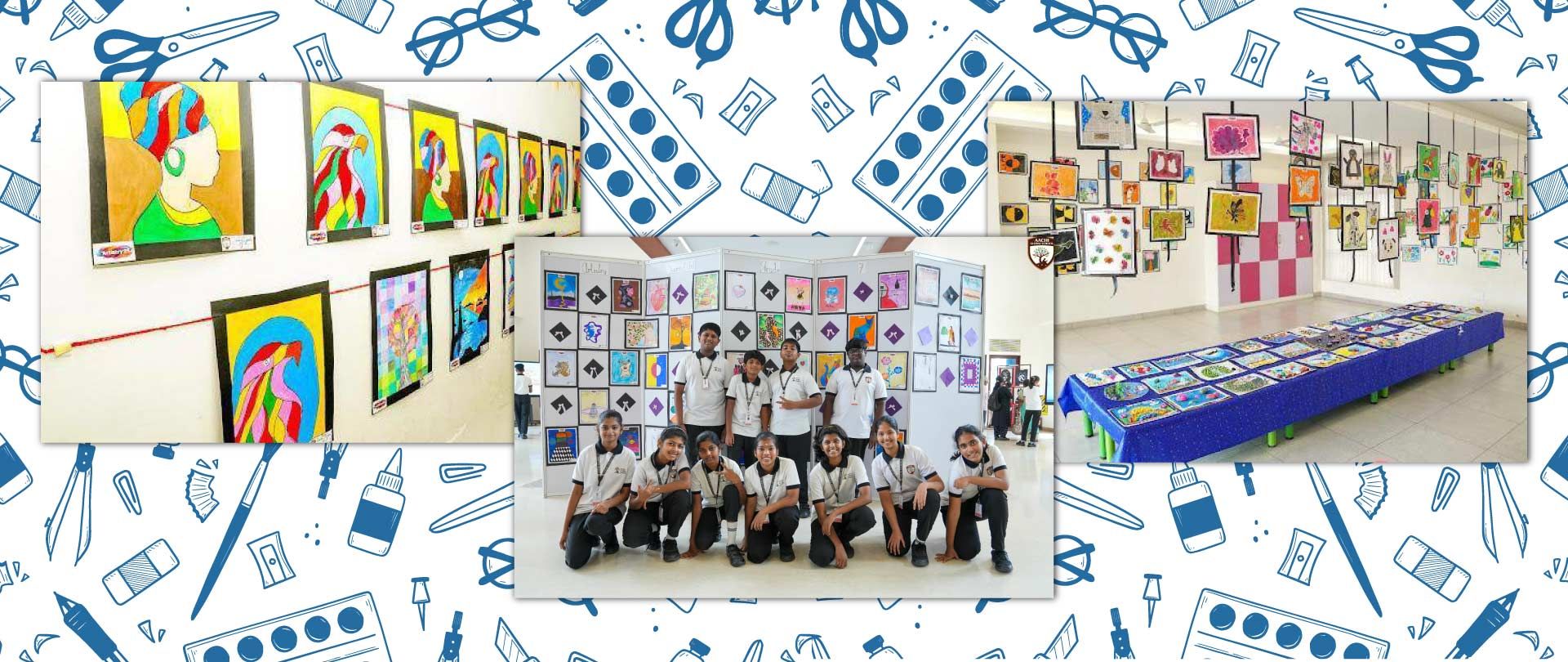“Art is not just seen—it is felt by the heart.”
Think of a learning space where brushes paint emotions, rhythms guide minds, and every gesture becomes a lesson. That’s the role of art in education. Our world runs on creativity—from entertainment to engineering—making life more meaningful, efficient, and aesthetically rich.
The true importance of art in education lies in its ability to nurture creativity, imagination, and emotional growth in students. Art is more than just a subject—it's a form of expression that includes music, dance, drama, and visual arts.
The concept of art education teaches much more than aesthetics, as tt allows children to explore new ideas, build confidence, and develop a deeper understanding of themselves and the world around them.
In this blog post from Aachi Global School, you’ll discover the importance of art and how it shapes the young minds in detail.
At Aachi Global School (AGS), the importance of art in life is at the heart of our approach. Through creative activities, students explore self-expression, building confidence and joy in a nurturing environment. Enrol today—admissions for 2025–26 are open at AGS!
What Is Art Education and Why Does It Matter in a Child’s School Life?

Art education introduces children to creative disciplines such as painting, music, dance, and drama within the school curriculum. More than just an outlet for creativity, it plays a vital role in a child’s emotional, cognitive, and social development.
By engaging in artistic activities, students learn to express themselves, think critically, and approach problems with imagination and empathy. The role of art in education also extends to enhancing memory, focus, and academic performance. It encourages collaboration, cultural awareness, and emotional well-being.
The true concept of art education helps children develop confidence and a deeper understanding of the world around them. When schools prioritise art alongside traditional subjects, they nurture well-rounded individuals prepared for the complexities of life and learning in the 21st century.
Now that we’ve seen the introduction of art education, it’s time to understand its deeper significance.
Key Reasons Behind the Importance of Art in Education

Reason 1: Fosters Creative Thinking and Expression
Art education in schools allows students to express their individuality, thoughts, and emotions in ways that traditional academics may not.
Whether through painting, music, dance, or drama, students learn to think outside the box and explore different forms of communication.
This creativity nurtured from a young age can lead to enhanced problem-solving skills, innovation, and flexibility in thinking, which are crucial for success in the modern world.
Reason 2: Enhances Emotional and Social Development
Art plays a vital role in helping children understand and express their feelings. Participating in group art activities fosters teamwork, empathy, and respect for diverse perspectives.
It also builds self-confidence as children learn to showcase their work and receive feedback.
The importance of performing arts further enhances emotional intelligence and social adaptability, positively influencing students’ relationships and mental well-being.
Reason 3: Supports Cognitive and Academic Growth
Students involved in art education often show improved memory, sharper focus, and higher academic success.
For example, learning rhythm in music can enhance mathematical skills, while storytelling through drama supports language development.
Art helps students make cross-curricular connections, making their learning experiences richer and more meaningful.
Schools that integrate art tend to show improved performance in core academic subjects.
Recent Post: Beyond Academics: Importance of Co-Curricular Activities in School
5 Incredible Benefits of Art in Schools That Drive Creativity

1. Improves Motor Skills and Coordination
From cutting with scissors to moulding clay or performing dance routines, art activities significantly improve fine motor skills and hand-eye coordination in young children.
The benefits of art education extend beyond creativity—they support crucial developmental milestones.
These skills are not just important for artistic expression but also play a key role in daily activities like writing, typing, or using tools.
For younger students, early exposure to such tasks enhances overall physical development.
2. Boosts Academic Performance
The relation between art and education is clear—doing art activities helps both sides of the brain work better, which boosts thinking skills and helps solve problems.
Students who participate in the arts often show improved performance in subjects like math, science, and reading.
The discipline, focus, and perseverance learned in mastering an art form can translate to better academic outcomes.
Art projects also teach students how to follow instructions, meet deadlines, and organise their work.
3. Reduces Stress and Enhances Mental Health
Art offers a healthy outlet for stress relief. In a school setting where academic pressure can be overwhelming, art classes provide a space for relaxation and self-expression.
Whether it’s through painting or playing an instrument, students can unwind and recharge emotionally.
The importance of art in life is evident as it significantly boosts mental health, increases classroom participation, and creates a more positive learning environment.
4. Encourages Long-Term Career Opportunities
Art education opens doors to diverse career paths—graphic design, animation, fashion, photography, music, architecture, and more.
As the creative industry continues to grow, the importance of art in education becomes evident, with skills learned in school art programs becoming increasingly valuable.
Schools that offer strong art education help students identify their passions early, laying the foundation for future professional success in the creative economy.
5. Enhances Language Skills through Artistic Expression
Art activities like theatre, poetry, and creative writing naturally boost language development.
Students effortlessly expand vocabulary, strengthen grammar, and improve fluency in an engaging, enjoyable environment, making language learning both effective and fun.
This immersive approach cultivates confidence in communication and nurtures a lifelong love for language.
Suggested Read: Innovative Teaching Methods at AGS for Educational Excellence
Future-Ready Learning with Art at Aachi Global School (AGS)

Art education in schools is not merely an extracurricular activity but a vital pillar in nurturing well-rounded, creative, and confident individuals.
At Aachi Global School (AGS), with campuses in Anna Nagar and Ayanambakkam, our commitment to holistic development is evident in every aspect of the learning journey.
With a deep focus on the importance of art in education, AGS equips students with spaces that inspire artistic growth:
A. Art Lab

Our art lab is a dynamic space that nurtures creativity, allowing students to explore various art forms, experiment freely, and build both artistic skills and imaginative thinking through engaging, hands-on experiences.
B. Music Lab

Equipped with diverse instruments and recording facilities, supporting musical exploration and performance.
C. Dance Studio

Professionally designed for movement arts, encouraging self-expression and confidence.
Suggested Read: What is Holistic Education and Why it’s Important for Every Student?
The Artistry 2025: AGS Celebrates Passion, Performance & Potential
At Aachi Global School, our dedication to nurturing creativity came alive through “The Artistry 2025” – a milestone event that celebrated student talent across all grades.
Our campus turned into a vibrant gallery, showcasing paintings, sketches, sculptures, digital art, and live installations. The event powerfully reflected the importance of art in life, encouraging students to express themselves and think critically.
Every student, from kindergarten to senior levels, was given a platform to share their unique vision. Live demonstrations, interactive booths, and creative workshops further highlighted the importance of performing arts in building confidence and emotional intelligence.
Suggested Read: AGS 2024 REWIND: Celebrating a Year of Learning, Achievements & Legacy
Conclusion
To sum up, art plays a powerful role in shaping well-rounded learners. The importance of art in education goes beyond just learning to draw or perform—it builds confidence, boosts creativity, and enhances emotional growth.
At Aachi Global School, students engage in hands-on learning through spaces like the Art Lab, Music Lab, and Dance Studio.
The role of art in education is clear in how it supports academic success, encourages collaboration, and nurtures individual expression. Events like The Artistry 2025 allow students to showcase their talent and learn through experience.
Overall, the benefits of art in schools are immense, fostering critical thinking, reducing stress, and opening doors to future careers. Join Aachi Global School for a truly holistic learning journey. Admissions for 2025–26 are now open. Enrol now!
Unlock more educational content and enriching topics—check out our regularly updated blog and get inspired today. Start exploring now!
FAQs
1. What Is the Importance of Art in Education?
Art in education nurtures creativity, critical thinking, and emotional expression. It enhances academic learning by encouraging innovation, boosting confidence, and improving communication skills, making students more well-rounded, expressive, and culturally aware individuals.
2. What Is the Relationship Between Art and Education?
Art and education are interconnected, as art enhances cognitive abilities and learning processes. Through artistic activities, students develop problem-solving, observation, and empathy, key elements that strengthen overall educational experiences and encourage personal growth.
3. What Is the Nature and Scope of Art Education?
Art education includes visual arts, music, drama, and dance, offering students diverse forms of expression. Its scope extends to skill-building, emotional development, cultural awareness, and interdisciplinary learning, fostering holistic development across all levels of schooling.
4. Why Is Art Important in Education?
Art is vital in education because it promotes creativity, builds confidence, and encourages exploration. It helps students understand abstract concepts, improves focus, and allows self-expression, supporting both academic and emotional growth in an engaging, interactive way.
5. Why Is Art Important in Our Lives?
Art enriches our lives by offering a medium to express emotions, reflect culture, and inspire creativity. It helps build empathy, connects communities, and enhances our ability to perceive and interpret the world meaningfully and aesthetically.
6. What Is the Place of Art in Education?
Art holds a crucial place in education by supporting cognitive, social, and emotional development. It complements core subjects by enhancing creativity and understanding, making learning more dynamic and engaging across all student age groups.
7. Why Is Art Important for Students?
Art is important for students as it boosts imagination, fine motor skills, and emotional expression. It enhances confidence, communication, and cultural sensitivity, preparing them for success in academics and life through creative and reflective thinking.
8. What Are the Benefits of Art Education in Schools?
Art education improves academic performance, enhances motor skills, and strengthens creativity. It promotes cultural awareness, emotional intelligence, collaboration, and critical thinking, making students more adaptive and expressive in both school and real-world environments.
9. What Are the Two Types of Art Education?
The two main types of art education are visual arts (drawing, painting, sculpture) and performing arts (music, dance, drama). Both forms encourage expression, creativity, and skill-building through hands-on learning and active participation.
10. How Does Art Education Support Emotional Well-Being?
Art education supports emotional well-being by offering a healthy outlet for self-expression, reducing stress, and building confidence. It encourages mindfulness, empathy, and emotional awareness, helping students process emotions constructively and develop resilience.
11. What Skills Do Students Learn from Art Education?
Students gain creativity, critical thinking, collaboration, communication, and problem-solving skills through art education. They also develop fine motor coordination, visual literacy, emotional intelligence, and an appreciation for diversity, contributing to their overall personal and academic development.




